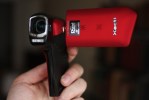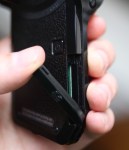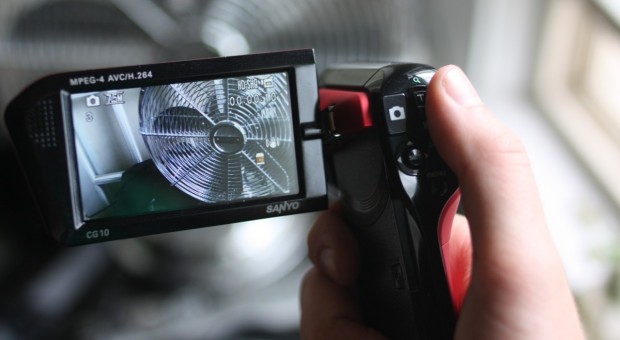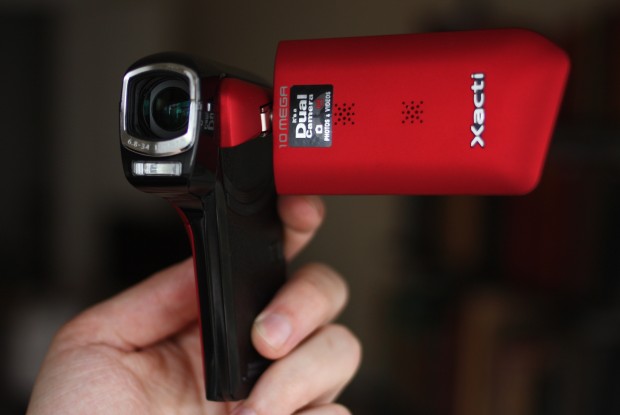
Short version: An excellent casual HD camcorder with superior image quality to pocket cams and a flexible focus system, making it useful for bloggers like me as well. At under $200 this thing is absolutely a steal.
Full review
A while back I was at AMD’s overclocking challenge, and for shooting video I had a Kodak Zx1 and a Casio Exilim FC-100 for slow motion. Both are great cameras, but 720p on either one is a bit indistinct, and the Zx1 has a fixed focus lens, which makes up-close shots difficult. Vince from SlashGear had a pistol-grip Sanyo, which I had dismissed before as gimmicky, but having gotten a chance to handle it, I decided I liked it and would pick up the next generation when they came out. Well, they came out a while back and I’ve been using it since. And now I’m reviewing it.
There are a few cameras like this one, so let’s be clear: I’m talking about the CG10, which is sort of the lowest-end Sanyo you can get. 720p is its maximum resolution, which is more than enough for any home video or web media. They make a big deal about how “It’s a Dual Camera! Photos & Videos” but really now, camcorders have been taking pictures for years and years, and I don’t advise doing it if you don’t have to.
Build and layout
The CG10 differs from many other cheap camcorders and pocketcams in that it actually has a real lens. It’s far from a real real lens, but it’s not the fixed-focus pinhole crap you see on Flips, Kodaks, and Nanos. This means it has a 5x optical zoom and better light sensitivity than those other options, at the cost of a slightly larger size.
The CG10 is about the size of a large mouse, just to give you a general idea. It feels pleasantly weighty and is well-balanced. Remember, this isn’t a pocket camcorder, it’s merely compact; it’s certainly small enough to bring everywhere, but unlike a Flip (or an iPod Nano, I suppose) it’s not a front-pocket kind of thing. Though it does sit comfortably in your back pocket if your pants aren’t too tight. Just don’t sit down on it.
As you can see in the pictures, it’s got a nice little 3″ flip-out LCD, which is bright and reasonably sharp. Controls are all situated for your thumb to operate; your other fingers have nothing to do but grip. This works pretty well once you get the layout down. The menu layout is the normal sort of thing, though I have to say I searched for ages for a way to delete things on camera before I realized that the “menu” button was taking me to the wrong place. The usual options are there, with several choices for exposure control, stabilization, and face tracking.
Quality and features
One feature I found extremely handy was the manual focus mode. For keeping a device in focus while I or my hand move in and out of the shot, it’s invaluable. I used it (to great effect) in my Zune HD and Sleek SA-6 reviews. Its macro mode focuses down to 1cm, which is fantastic for getting close-ups of components, plus it gives a great depth of field effect. I found the autofocus to be a bit slow in general (though accurate), so I use manual whenever I can.
For a $200 camera, I found color and sharpness to be good, though the small sensor and major compression mean motion will always be kind of smeary. Of course if you whip it back and forth you’ll get that wobbly skew action, but that’s something you can avoid. Exposure was pretty decent, and you can select center-weighted or spot, but not manual. Low light performance is nothing to write home about, but again we’re talking about a $200 camera here. Make sure you have your lights on or you’ll be seeing noise.
Sound is pretty basic, and the microphones are located on the back of the LCD, which is good if you’re filming the thing creating the sound. Bad if you’re filming yourself and you have reversed the LCD so you can make sure you’re in frame. I didn’t have any issue with the sound other than the fact that it was about as medium-quality as you can expect from a budget device.
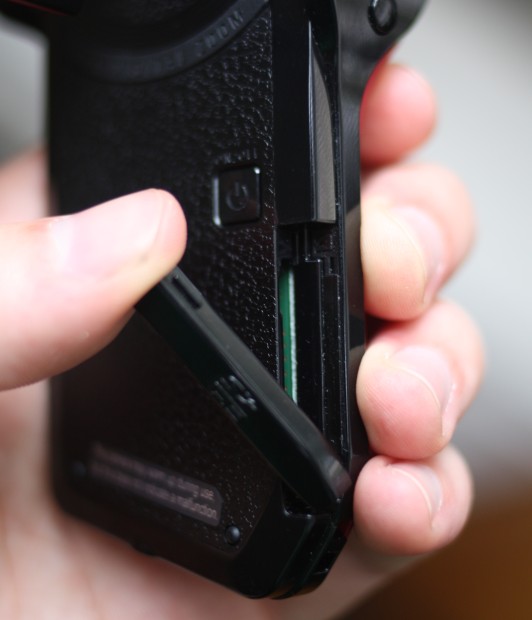 Battery life seemed normal for a small camcorder with no moving parts. The battery is removable and comes with a charger, as you might expect. No surprises here.
Battery life seemed normal for a small camcorder with no moving parts. The battery is removable and comes with a charger, as you might expect. No surprises here.
File sizes are manageable. I set it immediately to the highest quality and a 22-second video took up 25MB, for reference. 640×480 should be about half that, though it will also shoot 640×480 at 60FPS, which obviously will take up more space. It uses H.264 and the files are MP4. It has a tiny amount of internal space (40MB) so you’ll be shooting to SD. One annoying thing I found was that the SD slot can’t be accessed without flipping the LCD up and consequently turning on the camera. Not a big deal but vexing nonetheless.
Bottom line
The Sanyo Xacti VPC-CG10 can be found for far less than $200, and I think at $200 it was already a good deal. It’s not pocketable, but in every other respect it bests the pocket-cam army. If you’re looking for a basic around-the-house camcorder, I highly recommend the CG10.
